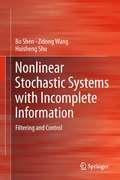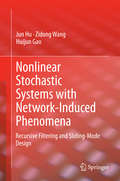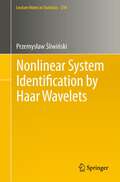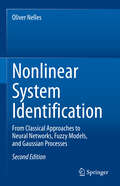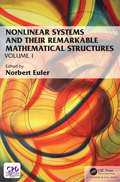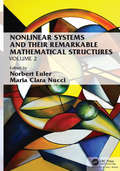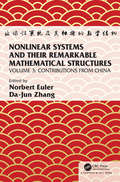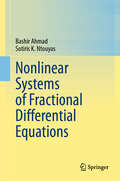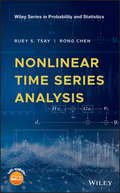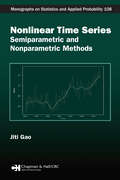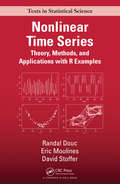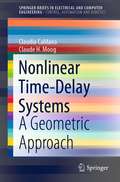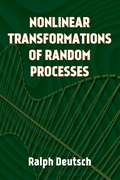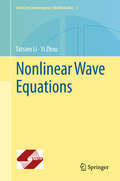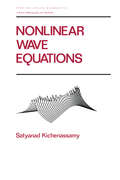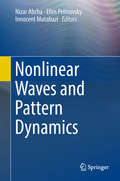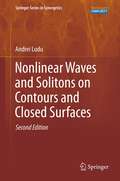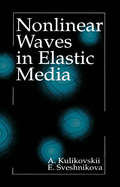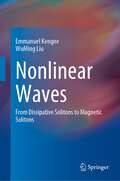- Table View
- List View
Nonlinear Stochastic Systems with Incomplete Information
by Huisheng Shu Zidong Wang Bo ShenNonlinear Stochastic Processes addresses the frequently-encountered problem of incomplete information. The causes of this problem considered here include: missing measurements; sensor delays and saturation; quantization effects; and signal sampling. Divided into three parts, the text begins with a focus on H filtering and control problems associated with general classes of nonlinear stochastic discrete-time systems. Filtering problems are considered in the second part, and in the third the theory and techniques previously developed are applied to the solution of issues arising in complex networks with the design of sampled-data-based controllers and filters. Among its highlights, the text provides: * a unified framework for filtering and control problems in complex communication networks with limited bandwidth; * new concepts such as random sensor and signal saturations for more realistic modeling; and * demonstration of the use of techniques such as the Hamilton-Jacobi-Isaacs, difference linear matrix, and parameter-dependent matrix inequalities and sums of squares to handle the computational challenges inherent in these systems. The collection of recent research results presented in Nonlinear Stochastic Processes will be of interest to academic researchers in control and signal processing. Graduate students working with communication networks with lossy information and control of stochastic systems will also benefit from reading the book.
Nonlinear Stochastic Systems with Network-Induced Phenomena
by Zidong Wang Huijun Gao Jun HuThis monograph introduces methods for handling filtering and control problems in nonlinear stochastic systems arising from network-induced phenomena consequent on limited communication capacity. Such phenomena include communication delay, packet dropout, signal quantization or saturation, randomly occurring nonlinearities and randomly occurring uncertainties. The text is self-contained, beginning with an introduction to nonlinear stochastic systems, network-induced phenomena and filtering and control, moving through a collection of the latest research results which focuses on the three aspects of: · the state-of-the-art of nonlinear filtering and control; · recent advances in recursive filtering and sliding mode control; and · their potential for application in networked control systems, and concluding with some ideas for future research work. New concepts such as the randomly occurring uncertainty and the probability-constrained performance index are proposed to make the network models as realistic as possible. The power of combinations of such recent tools as the completing-the-square and sums-of-squares techniques, HamiltonJacobiIsaacs matrix inequalities, difference linear matrix inequalities and parameter-dependent matrix inequalities is exploited in treating the mathematical and computational challenges arising from nonlinearity and stochasticity. Nonlinear Stochastic Systems with Network-Induced Phenomena establishes a unified framework of control and filtering which will be of value to academic researchers in bringing structure to problems associated with an important class of networked system and offering new means of solving them. The significance of the new concepts, models and methods presented for practical control engineering and signal processing will also make it a valuable reference for engineers dealing with nonlinear control and filtering problems.
Nonlinear Structural Dynamics Using FE Methods
by James F. DoyleNonlinear Structural Dynamics Using FE Methods emphasizes fundamental mechanics principles and outlines a modern approach to understanding structural dynamics. The book will be useful to practicing engineers, giving them a richer understanding of the use of their trade and thus accelerating learning on new problems. Independent workers will find access to advanced topics presented in an accessible manner. The book successfully tackles the challenge of how to present the fundamentals of structural dynamics and infuse it with finite element (FE) methods. First, the author establishes and develops mechanics principles that are basic enough to form the foundations of FE methods. Second, the book presents specific computer procedures to implement FE methods so that general problems can be "solved" - that is, responses can be produced given the loads, initial conditions, and so on. Finally, the book introduces methods of analyses to leverage and expand the FE solutions.
Nonlinear System Identification by Haar Wavelets
by Przemysław SliwinskiIn order to precisely model real-life systems or man-made devices, both nonlinear and dynamic properties need to be taken into account. The generic, black-box model based on Volterra and Wiener series is capable of representing fairly complicated nonlinear and dynamic interactions, however, the resulting identification algorithms are impractical, mainly due to their computational complexity. One of the alternatives offering fast identification algorithms is the block-oriented approach, in which systems of relatively simple structures are considered. The book provides nonparametric identification algorithms designed for such systems together with the description of their asymptotic and computational properties.
Nonlinear System Identification: From Classical Approaches to Neural Networks, Fuzzy Models, and Gaussian Processes
by Oliver NellesThis book provides engineers and scientists in academia and industry with a thorough understanding of the underlying principles of nonlinear system identification. It equips them to apply the models and methods discussed to real problems with confidence, while also making them aware of potential difficulties that may arise in practice. Moreover, the book is self-contained, requiring only a basic grasp of matrix algebra, signals and systems, and statistics. Accordingly, it can also serve as an introduction to linear system identification, and provides a practical overview of the major optimization methods used in engineering. The focus is on gaining an intuitive understanding of the subject and the practical application of the techniques discussed. The book is not written in a theorem/proof style; instead, the mathematics is kept to a minimum, and the ideas covered are illustrated with numerous figures, examples, and real-world applications. In the past, nonlinear system identification was a field characterized by a variety of ad-hoc approaches, each applicable only to a very limited class of systems. With the advent of neural networks, fuzzy models, Gaussian process models, and modern structure optimization techniques, a much broader class of systems can now be handled. Although one major aspect of nonlinear systems is that virtually every one is unique, tools have since been developed that allow each approach to be applied to a wide variety of systems.
Nonlinear Systems and Their Remarkable Mathematical Structures: Volume 1
by Norbert EulerNonlinear Systems and Their Remarkable Mathematical Structures, Volume 1 aims to describe the recent progress in nonlinear differential equations and nonlinear dynamical systems (both continuous and discrete). Written by experts, each chapter is self-contained and aims to clearly illustrate some of the mathematical theories of nonlinear systems. The book should be suitable for some graduate and postgraduate students in mathematics, the natural sciences, and engineering sciences, as well as for researchers (both pure and applied) interested in nonlinear systems. The common theme throughout the book is on solvable and integrable nonlinear systems of equations and methods/theories that can be applied to analyze those systems. Some applications are also discussed.Features: Collects contributions on recent advances in the subject of nonlinear systems Aims to make the advanced mathematical methods accessible to the non-expert in this field Written to be accessible to some graduate and postgraduate students in mathematics and applied mathematics Serves as a literature source in nonlinear systems
Nonlinear Systems and Their Remarkable Mathematical Structures: Volume 2
by Norbert Euler Maria NucciNonlinear Systems and Their Remarkable Mathematical Structures, Volume 2 is written in a careful pedagogical manner by experts from the field of nonlinear differential equations and nonlinear dynamical systems (both continuous and discrete). This book aims to clearly illustrate the mathematical theories of nonlinear systems and its progress to both non-experts and active researchers in this area. Just like the first volume, this book is suitable for graduate students in mathematics, applied mathematics and engineering sciences, as well as for researchers in the subject of differential equations and dynamical systems. <P><P>Features <li>Collects contributions on recent advances in the subject of nonlinear systems <li>Aims to make the advanced mathematical methods accessible to the non-experts <li>Suitable for a broad readership including researchers and graduate students in mathematics and applied mathematics
Nonlinear Systems and Their Remarkable Mathematical Structures: Volume 3, Contributions from China
by Norbert EulerThe third volume in this sequence of books consists of a collection of contributions that aims to describe the recent progress in nonlinear differential equations and nonlinear dynamical systems (both continuous and discrete). Nonlinear Systems and Their Remarkable Mathematical Structures: Volume 3, Contributions from China just like the first two volumes, consists of contributions by world-leading experts in the subject of nonlinear systems, but in this instance only featuring contributions by leading Chinese scientists who also work in China (in some cases in collaboration with western scientists). Features Clearly illustrate the mathematical theories of nonlinear systems and its progress to both the non-expert and active researchers in this area Suitable for graduate students in Mathematics, Applied Mathematics and some of the Engineering sciences Written in a careful pedagogical manner by those experts who have been involved in the research themselves, and each contribution is reasonably self-contained
Nonlinear Systems of Fractional Differential Equations
by Bashir Ahmad Sotiris K. NtouyasThis book studies the theoretical aspects for a variety of coupled fractional differential systems involving Riemann-Liouville, Caputo, ψ-Riemann--Liouville, Hilfer, ψ--Hilfer, Hadamard, Hilfer--Hadamard, Erdelyi--Kober, (k, ψ)-Hilfer, generalized, Proportional, ψ-Proportional, Hilfer--proportional, ψ-Hilfer--proportional type fractional derivative operators, subject to different types of nonlocal boundary conditions. The topic of fractional differential systems is one of the hot and important topics of research as such systems appear in the mathematical modeling of physical and technical phenomena. As the book contains some recent new work on the existence theory for nonlocal boundary value problems of fractional differential systems, it is expected that it will attract the attention of researchers, modelers and graduate students who are interested in doing their research on fractional differential systems.
Nonlinear Theory of Electroelastic and Magnetoelastic Interactions
by Luis Dorfmann Ray W. OgdenThis book provides a unified theory on nonlinear electro-magnetomechanical interactions of soft materials capable of large elastic deformations. The authors include an overview of the basic principles of the classic theory of electromagnetism from the fundamental notions of point charges and magnetic dipoles through to distributions of charge and current in a non-deformable continuum, time-dependent electromagnetic fields and Maxwell's equations. They summarize relevant theories of continuum mechanics, required to account for the deformability of material and present a constitutive framework for the nonlinear magneto-and electroelastic interactions in a highly deformable material. The equations contained in the book formulate and solve a variety of representative boundary-value problems for both nonlinear magnetoelasticity and electroelasticity.
Nonlinear Theory of Generalized Functions
by Michael Grosser; Günther Hörmann; Michael Kunzinger; Michael OberguggenbergerQuestions regarding the interplay of nonlinearity and the creation and propagation of singularities arise in a variety of fields-including nonlinear partial differential equations, noise-driven stochastic partial differential equations, general relativity, and geometry with singularities. A workshop held at the Erwin-Schrödinger International Institute for Mathematical Physics in Vienna investigated these questions and culminated in this volume of invited papers from experts in the fields of nonlinear partial differential equations, structure theory of generalized functions, geometry and general relativity, stochastic partial differential equations, and nonstandard analysis.The authors provide the latest research relevant to work in partial differential equations, mathematical physics, and nonlinear analysis. With a focus on applications, this books provides a compilation of recent approaches to the problem of singularities in nonlinear models. The theory of differential algebras of generalized functions serves as the central theme of the project, along with its interrelations with classical methods.
Nonlinear Time Series Analysis
by Holger Kantz Thomas SchreiberThe paradigm of deterministic chaos has influenced thinking in many fields of science. Chaotic systems show rich and surprising mathematical structures. In the applied sciences, deterministic chaos provides a striking explanation for irregular behaviour and anomalies in systems which do not seem to be inherently stochastic. The most direct link between chaos theory and the real world is the analysis of time series from real systems in terms of nonlinear dynamics. Experimental technique and data analysis have seen such dramatic progress that, by now, most fundamental properties of nonlinear dynamical systems have been observed in the laboratory. Great efforts are being made to exploit ideas from chaos theory wherever the data displays more structure than can be captured by traditional methods. Problems of this kind are typical in biology and physiology but also in geophysics, economics, and many other sciences.
Nonlinear Time Series Analysis (Wiley Series in Probability and Statistics)
by Ruey S. Tsay Rong ChenA comprehensive resource that draws a balance between theory and applications of nonlinear time series analysis Nonlinear Time Series Analysis offers an important guide to both parametric and nonparametric methods, nonlinear state-space models, and Bayesian as well as classical approaches to nonlinear time series analysis. The authors—noted experts in the field—explore the advantages and limitations of the nonlinear models and methods and review the improvements upon linear time series models. The need for this book is based on the recent developments in nonlinear time series analysis, statistical learning, dynamic systems and advanced computational methods. Parametric and nonparametric methods and nonlinear and non-Gaussian state space models provide a much wider range of tools for time series analysis. In addition, advances in computing and data collection have made available large data sets and high-frequency data. These new data make it not only feasible, but also necessary to take into consideration the nonlinearity embedded in most real-world time series. This vital guide: • Offers research developed by leading scholars of time series analysis • Presents R commands making it possible to reproduce all the analyses included in the text • Contains real-world examples throughout the book • Recommends exercises to test understanding of material presented • Includes an instructor solutions manual and companion website Written for students, researchers, and practitioners who are interested in exploring nonlinearity in time series, Nonlinear Time Series Analysis offers a comprehensive text that explores the advantages and limitations of the nonlinear models and methods and demonstrates the improvements upon linear time series models.
Nonlinear Time Series: Semiparametric and Nonparametric Methods (Chapman & Hall/CRC Monographs on Statistics and Applied Probability)
by Jiti GaoUseful in the theoretical and empirical analysis of nonlinear time series data, semiparametric methods have received extensive attention in the economics and statistics communities over the past twenty years. Recent studies show that semiparametric methods and models may be applied to solve dimensionality reduction problems arising from using fully
Nonlinear Time Series: Theory, Methods and Applications with R Examples (Chapman & Hall/CRC Texts in Statistical Science)
by Randal Douc Eric Moulines David StofferThis text emphasizes nonlinear models for a course in time series analysis. After introducing stochastic processes, Markov chains, Poisson processes, and ARMA models, the authors cover functional autoregressive, ARCH, threshold AR, and discrete time series models as well as several complementary approaches. They discuss the main limit theorems for Markov chains, useful inequalities, statistical techniques to infer model parameters, and GLMs. Moving on to HMM models, the book examines filtering and smoothing, parametric and nonparametric inference, advanced particle filtering, and numerical methods for inference.
Nonlinear Time-Delay Systems: A Geometric Approach (SpringerBriefs in Electrical and Computer Engineering)
by Claudia Califano Claude H. MoogThis brief focuses on the structural properties of nonlinear time-delay systems. It provides a link between coverage of fundamental theoretical properties and advanced control algorithms, as well as suggesting a path for the generalization of the differential geometric approach to time-delay systems . The brief begins with an introduction to a class of single-input nonlinear time-delay systems. It then focuses on geometric methods treating them and offers a geometric framework for integrability. The book has chapters dedicated to the accessibility and observability of nonlinear time-delay systems, allowing readers to understand the systems in a well-ordered, structured way. Finally, the brief concludes with applications of integrability and the control of single-input time-delay systems. This brief employs exercises and examples to familiarize readers with the time-delay context. It is of interest to researchers, engineers and postgraduate students who work in the area of nonlinear control systems.
Nonlinear Transformations of Random Processes (Dover Books on Electrical Engineering)
by Ralph DeutschThis concise treatment of nonlinear noise techniques encountered in system applications is suitable for advanced undergraduates and graduate students. The book is also a valuable reference for systems analysts and communication engineers, as it discusses the basic mathematical theories of nonlinear transformations applied to random processes encountered in communications and control systems. Prerequisites include a familiarity with statistics, probability, complex variables, and Fourier and Laplace transforms. The first five chapters present specific classes of nonlinear devices and random processes that in combination lead to closed form solutions for the statistical properties of the transformed process. Subsequent chapters address techniques based on the use of series representations, general systematic approaches to the subject of nonlinear transformations of random processes, and sampling and quantizing a random process. A helpful Appendix features notes on hypergeometric functions.
Nonlinear Vibrations and the Wave Equation (Springerbriefs In Mathematics)
by Alain HarauxThis book gathers the revised lecture notes from a seminar course offered at the Federal University of Rio de Janeiro in 1986, then in Tokyo in 1987. An additional chapter has been added to reflect more recent advances in the field.
Nonlinear Water Waves: An Interdisciplinary Interface (Tutorials, Schools, and Workshops in the Mathematical Sciences)
by David Henry Konstantinos Kalimeris Emilian I. Părău Jean-Marc Vanden-Broeck Erik WahlénThe motion of water is governed by a set of mathematical equations which are extremely complicated and intractable. This is not surprising when one considers the highly diverse and intricate physical phenomena which may be exhibited by a given body of water. Recent mathematical advances have enabled researchers to make major progress in this field, reflected in the topics featured in this volume. Cutting-edge techniques and tools from mathematical analysis have generated strong rigorous results concerning the qualitative and quantitative physical properties of solutions of the governing equations. Furthermore, accurate numerical computations of fully-nonlinear steady and unsteady water waves in two and three dimensions have contributed to the discovery of new types of waves. Model equations have been derived in the long-wave and modulational regime using Hamiltonian formulations and solved numerically. This book brings together interdisciplinary researchers working in the field of nonlinear water waves, whose contributions range from survey articles to new research results which address a variety of aspects in nonlinear water waves. It is motivated by a workshop which was organised at the Erwin Schrödinger International Institute for Mathematics and Physics in Vienna, November 27-December 7, 2017. The key aim of the workshop was to describe, and foster, new approaches to research in this field. This is reflected in the contents of this book, which is aimed to stimulate both experienced researchers and students alike.
Nonlinear Wave Equations
by Tatsien Li Yi ZhouThis book focuses on nonlinear wave equations, which are of considerable significance from both physical and theoretical perspectives. It also presents complete results on the lower bound estimates of lifespan (including the global existence), which are established for classical solutions to the Cauchy problem of nonlinear wave equations with small initial data in all possible space dimensions and with all possible integer powers of nonlinear terms. Further, the book proposes the global iteration method, which offers a unified and straightforward approach for treating these kinds of problems. Purely based on the properties of solut ions to the corresponding linear problems, the method simply applies the contraction mapping principle.
Nonlinear Wave Equations (Chapman And Hall/crc Pure And Applied Mathematics Ser. #194)
by Satyanad KichenassamyThis work examines the mathematical aspects of nonlinear wave propagation, emphasizing nonlinear hyperbolic problems. It introduces the tools that are most effective for exploring the problems of local and global existence, singularity formation, and large-time behaviour of solutions, and for the study of perturbation methods.
Nonlinear Waves and Pattern Dynamics
by Efim Pelinovsky Nizar Abcha Innocent MutabaziThis book addresses the fascinating phenomena associated with nonlinear waves and spatio-temporal patterns. These appear almost everywhere in nature from sand bed forms to brain patterns, and yet their understanding still presents fundamental scientific challenges. The reader will learn here, in particular, about the current state-of-the art and new results in: Nonlinear water waves: resonance, solitons, focusing, Bose-Einstein condensation, as well as and their relevance for the sea environment (sea-wind interaction, sand bed forms, fiber clustering) Pattern formation in non-equilibrium media: soap films, chimera patterns in oscillating media, viscoelastic Couette-Taylor flow, flow in the wake behind a heated cylinder, other pattern formation. The editors and authors dedicate this book to the memory of Alexander Ezersky, Professor of Fluid Mechanics at the University of Caen Normandie (France) from September 2007 to July 2016. Before 2007, he had served as a Senior Scientist at the Institute of Applied Physics of the Russian Academy of Sciences in Nizhny Novgorod (Russia). The chapters have been written by leading scientists in Nonlinear Physics, and the topics chosen so as to cover all the fields to which Prof. Ezersky himself contributed, by means of experimental, theoretical and numerical approaches. The volume will appeal to advanced students and researchers studying nonlinear waves and pattern dynamics, as well as other scientists interested in their applications in various natural media.
Nonlinear Waves and Solitons on Contours and Closed Surfaces
by Andrei LuduThis volume is an introduction to nonlinear waves and soliton theory in the special environment of compact spaces such a closed curves and surfaces and other domain contours. It assumes familiarity with basic soliton theory and nonlinear dynamical systems. The first part of the book introduces the mathematical concept required for treating the manifolds considered, providing relevant notions from topology and differential geometry. An introduction to the theory of motion of curves and surfaces - as part of the emerging field of contour dynamics - is given. The second and third parts discuss the modeling of various physical solitons on compact systems, such as filaments, loops and drops made of almost incompressible materials thereby intersecting with a large number of physical disciplines from hydrodynamics to compact object astrophysics. This book is intended for graduate students and researchers in mathematics, physics and engineering. This new edition has been thoroughly revised, expanded and updated.
Nonlinear Waves in Elastic Media
by A.G. Kulikovskii Elena I. SveshnikovaNonlinear Waves in Elastic Media explores the theoretical results of one-dimensional nonlinear waves, including shock waves, in elastic media. It is the first book to provide an in-depth and comprehensive presentation of the nonlinear wave theory while taking anisotropy effects into account. The theory is completely worked out and draws on 15 years of research by the authors, one of whom also wrote the 1965 classic Magnetohydrodynamics. Nonlinear Waves in Elastic Media emphasizes the behavior of quasitransverse waves and analyzes arbitrary discontinuity disintegration problems, illustrating that the solution can be non-unique - a surprising result. The solution is shown to be especially interesting when anisotropy and nonlinearity effects interact, even in small-amplitude waves. In addition, the text contains an independent mathematical chapter describing general methods to study hyperbolic systems expressing the conservation laws. The theoretical results described in Nonlinear Waves in Elastic Media allow, for the first time, discovery and interpretation of many new peculiarities inherent to the general problem of discontinuous solutions and so provide a valuable resource for advanced students and researchers involved with continuum mechanics and partial differential equations.
Nonlinear Waves: From Dissipative Solitons to Magnetic Solitons
by Emmanuel Kengne WuMing LiuThis book highlights the methods to engineer dissipative and magnetic nonlinear waves propagating in nonlinear systems. In the first part of the book, the authors present methodologically mathematical models of nonlinear waves propagating in one- and two-dimensional nonlinear transmission networks without/with dissipative elements. Based on these models, the authors investigate the generation and the transmission of nonlinear modulated waves, in general, and solitary waves, in particular, in networks under consideration. In the second part of the book, the authors develop basic theoretical results for the dynamics matter-wave and magnetic-wave solitons of nonlinear systems and of Bose–Einstein condensates trapped in external potentials, combined with the time-modulated nonlinearity. The models treated here are based on one-, two-, and three-component non-autonomous Gross–Pitaevskii equations. Based on the Heisenberg model of spin–spin interactions, the authors also investigate the dynamics of magnetization in ferromagnet with or without spin-transfer torque. This research book is suitable for physicists, mathematicians, engineers, and graduate students in physics, mathematics, and network and information engineering.
